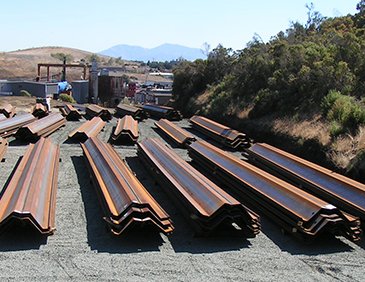
Steel piles can be rolled sections, fabricated shapes, or sheet piles. Two or more sheet pile sections can be connected in a box shape and driven as one pile. The primary benefit of using a steel pile is its load-carrying capacity. A steel pile can support up to 100 tons. Steel piles are most commonly used for large structure foundations with heavy loads.
Steel Piles Have a High Bearing Capacity:
Steel piles have a high bearing capacity.
Steel piles can be driven through tough layers or boulders.
The volume of soil displaced during steel pile driving is less.
Steel piles can withstand the abrasive treatment.
Steel Piles' Disadvantages:
Steel piles are prone to corrosion and electrolysis damage.
Unless the bearing stratum can develop a large pile capacity, steel piles are relatively expensive.
Steel piles perform less well than friction piles.

Steel Piles Corrosion:
Corrosion is a major issue with steel piles. The following are a few methods for protecting a steel pile from corrosion:
Thickness Increase
Most codes require that the pile section have a certain extra thickness (usually about 1/16 inch) in excess of the sectional area required for strength. This can be accomplished by subtracting 1/16 inch from the actual metal thickness when calculating pile capacity or by splicing another piece of steel to the pile length where corrosive action is expected.
Corrosive soil removal
Noncorrosive soils may be used to replace organic soils, cinder fill, unburned carbon, or industrial waste near the ground surface. Only when such soils are at shallow depths is this method cost-effective.
Encasement in concrete
By encasing the piles near the ground surface, where moisture and oxygen are abundant, the piles can be effectively protected. A large-scale concrete encasement is an expensive method.